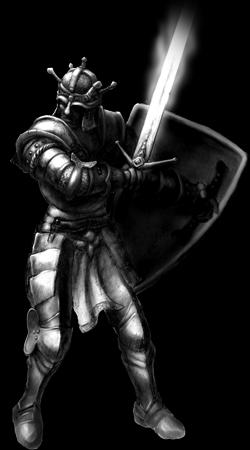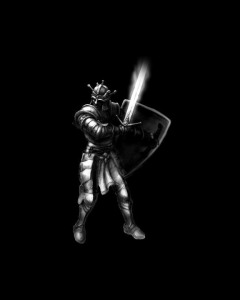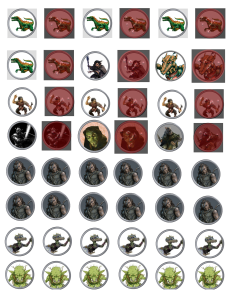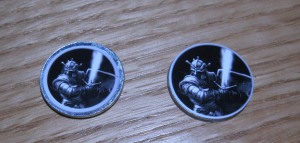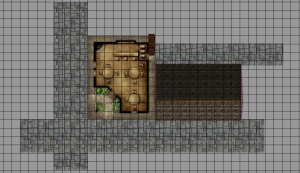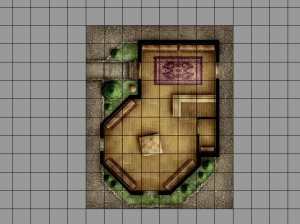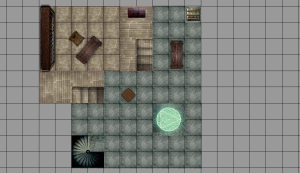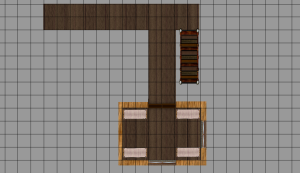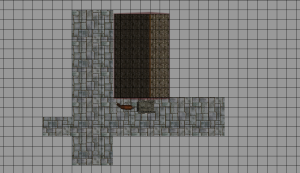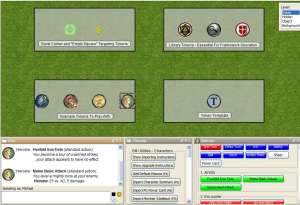Since yesterday was Free RPG Day, I decided to head down to my friendly local game store to participate in the festivities. Specifically, I knew from their Facebook feed and their podcast (yes, I listen to my local store’s podcast!) that they were running a free Dark Sun adventure. Since I’m never able to play in D&D Encounters thanks to my Wednesday night bowling league, I thought this would be a good chance for me to experience Dark Sun.
I went to the store a little before the 9:00 AM start time for the game, and had no trouble getting a seat at the table. We soon had the full six players, and a seventh showed up about 10 minutes after the hour, which the DM accommodated by handing her one of the player cards from Encounters. She played a second healer, which turned out to be much needed!
My character was a goliath fighter, a former gladiator in the city of Tyr who was fleeing the chaos in the city along with his adopted cousin and a friend, both clandestine arcane spellcasters (apparently arcane magic is taboo in much of the Dark Sun setting). We joined up with the other PCs, who were on a quest to get water for their people living in the mountains. We all signed on with a elven caravan going from Tyr to Alderak, hired to protect the elves and their cargo.
The first part of the adventure was a loose skill challenge or two about surviving the desert and badlands, which we had no trouble with. We were then set upon by raiders in a canyon for our first battle. I enjoyed role-playing my fighter throughout – he had 10 Intelligence and 8 Wisdom, so he wasn’t too bright and he was quite gullible, very willing to go along with whatever his allies wanted to do. He liked to smash bad guys with his sword and defend his buddies when they were in trouble. It’s all mechanics, but you can totally role-play these things, which I loved doing.
The battle with the raiders was most interesting for me because of the guy sitting next to me, who had never played an RPG before but who had apparently read up on things a little bit before coming into the store. His character was a wizard, and he found himself surrounded by minions before he could act, so he was thrown right into the fire of having to learn about opportunity attacks. Every single power that his character had was either ranged or area, which means that if he cast them while standing next to a bad guy, the baddie would get an opportunity attack on him. I believe he took Second Wind in the first round, then was able to shift away and start blasting in the second round after the rest of the group had pushed some of the minions away from him. It was fun to see him learning what he could do, including trying to climb a cliff to get out of harm’s way (with 8 Strength, that didn’t go as well as he would have liked).
I did get a DM lesson out of this battle. The DM generally did a great job all day, with lots of role-playing of the bad guys and description of the effects of attacks and so on. However, he made one decision that I would have changed. The minions in this particular battle only took one hit to kill, as with typical minions, but they would then keep fighting until the end of their next turns, at which point they would drop. I have no problem with the mechanic, and the adventure writers tried to give some flavor for it. Where I would have done things differently, though, is on critical hits. Crits on these minions were treated just like any one-damage attack, and the minion still got its next round of actions before dying. I think it would have made the players feel more awesome if a critical hit would kill one of those minions outright, rather than letting it fight on for another turn. It’s a minor point, but it’s the type of thing that I would change on the fly to make the game more fun for the players.
After the canyon battle, the party arrived at Alderak and hung out in an elven marketplace while the guy who hired us went into a tent. My guy, being rather dumb and oblivious, had no clue that anything was fishy, but some of the other PCs didn’t trust the elf who hired us and tried to follow him. The DM basically said no – which was okay in this case, because the PCs in question happened to roll low on their Insight checks.
Sure enough, the party was soon ambushed by something like eight elven archers and four insects, all of whom acted in a surprise round while only one of our characters acted. Then the bad guys went first in the first round of combat. Before I had a chance to act (despite getting a 19 on initiative in this battle, after the 3 I rolled in the last one) I was on the ground making death saves, soon joined by another ally. Our healer brought me back on her turn, at which point I was immediately dropped again. The elf leader came back out of the tent, and he was soon killed by two of the other PCs, at which point the town guards showed up and sorted everything out.
This particular battle didn’t feel like it was very well designed. Being able to take down two PCs (one of them twice) before they even have a chance to act seems far too harsh. And then having the battle immediately end halfway through that round when the surviving PCs dropped the leader seemed anticlimactic. I guess this was how this battle was intended to go, but two or three of our PCs didn’t even get to their spot in the initiative order before the battle ended. It didn’t seem like much fun.
Anyway, the authorities established that we were in the right here, and so they arranged for our party to be paid what it was owed. In addition, they let us face the elves in the arena games that were going on. Here is where things got pretty cool. Instead of a simple arena combat (which is what I think the written adventure called for), our DM modified things to make it an interesting game. The two sides (the party and the wicked elves) started on opposite sides of the arena (east and west). In the middle was a pile of seven huge ceramic coins – big enough that they required two hands to carry, but no check to pick them up or move them. At the north end was a closed chest for our team, and at the south end was a closed chest for the elves. The goal of the game was to have more coins in your chest than your opponents have in theirs when the battle ends at some unknown time in the future.
The real twist was that we were not allowed to deal any damage directly to one another – doing so would result in forfeit for the team that dealt the damage. However, the arena was littered with lots of razor vine, which would deal 5 damage to any creature that began its turn in the vines. Most of the elves were minions, so if we could push or pull them into the brambles, that would be fine within the rules and would kill them off.
The elves acted first and managed to get three coins into their chest right off the bat. We had an ace in the hole, though – our wizard had Sleep prepared, which was awesome. Our team grabbed some coins, shoved some minions into vines, etc. The tide was about even, when suddenly three monster hounds of some sort were released into the arena and started attacking everyone. Fortunately, we were allowed to fight back, but this would distract from the coin game. Still, our team took the upper hand after taking a coin from the elves’ chest, putting it in ours (giving us four of the seven coins), closing the lid to out chest and then having a PC stand on top of the chest.
My fighter and our barbarian were keeping the hounds occupied, and the hounds had just dropped (but not totally killed) the barbarian when the elf leader saw the handwriting on the wall. The evil elf knew that the game was lost, and since the DM said, “This is Dark Sun after all,” the elf decided to coup de grace our unconscious barbarian. The authorities immediately declared our team the winners and said that we were free to fight to the death now (it’s worth noting that this was a one-shot game, and this was the final encounter).
I followed with what I thought was a winning move. Surrounded by the two remaining hounds, both of which were bloodied, I Cleaved. I critted on the attack roll, so I killed off one hound and dealt 5 damage to the other. That wasn’t enough to kill the second hound, but since it was standing next to the elf leader and the hounds had a history of going after the closest person, I shifted away, figuring that the hound would kill the elf. He almost did, but the DM decided that would be anticlimactic, so he had the hound come after me instead, which dropped me. Then the elf coup de graced me as well. Finally, our wizard killed the last hound and the elf with one spell.
Even though my character was killed off, I didn’t really mind. It was the last battle, and I understood that it was appropriate for the Dark Sun setting. I had a good time at the game and I think I picked up a couple of lessons. I don’t think the Dark Sun setting is my particular cup of tea, but I know that lots of gamers out there love it, so good for them!
I do want to mention one final note about Free RPG Day. The store was offering 20% off all RPG products, which I hadn’t realized until the afternoon when I was listening to the store’s podcast as I mowed the lawn. They mentioned that the store was open from 7:00 AM until midnight on Free RPG Day, so I figured I’d stop on by in the evening to pick up Divine Power and Monster Manual 3, two books I’ve had my eye on. I went to the store a little after 9:00 PM and saw that they didn’t have MM3 on the shelf, but they did have Divine Power. I went to the register to buy my books, asking about MM3 and hoping to get a rain check (no luck). When the cashier rang up Divine Power, it came up to full price plus tax. I asked about the 20% discount for Free RPG Day that they had advertised, and she told me, “That ended at seven o’clock.”
Um, what? The store’s web site and podcast clearly talked about Free RPG Day lasting until midnight. I put the book back and left. I’ve emailed the store owner, whom I know very well from having purchased lots of D&D and Magic stuff in the past, and I’m expecting that he’ll honor the discount. Assuming he does (and I’ll post the resolution here, of course), I’ll trumpet this as the clear reason that you should support your friendly local game store – they’re not a faceless corporation, and they’ll make things right when problems come up. If for some reason he fails to correct this, though, my faith in local stores will be shaken. I really want to support them, but this is the sort of thing that will send me to Amazon with a clean conscience. Here’s hoping the FLGS comes through!
Edit: I’m happy to say that the owner of the store got back to me promptly and said that this was indeed just a miscommunication with the employee, and that the discounts were supposed to be in place all day. Even better, they DO have MM3 in stock and have set both it and Divine Power aside for me to come and get at 20% off. The friendly local game store comes through with flying colors!



